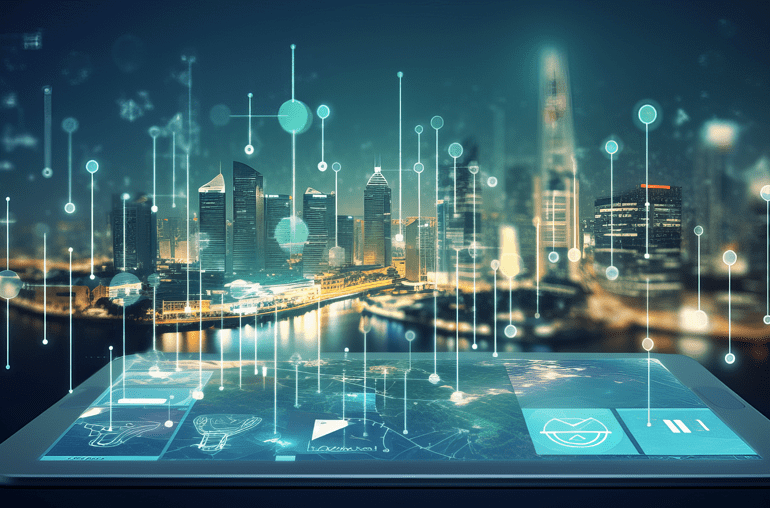
As urban areas continue to evolve and adapt to the demands of a rapidly changing world, the concept of smart cities has emerged as a transformative force. With the integration of advanced technologies and data-driven solutions, there is an opportunity for cities to become more efficient and sustainable than ever before.
In this blog post, we’ll explore 10 emerging technologies for smart cities and how they are reshaping the urban landscape of tomorrow.
10 Smart City Trends
In the world of smart cities, trends and applications move fast. Stay ahead of the curve by keeping an eye on these latest innovations.
1. Smart Buildings
Smart buildings are equipped with sensors and systems that allow intelligent monitoring, control, and optimization of various functions. The goal is to enhance the structure’s efficiency and sustainability while improving the occupants’ overall comfort and experience.
One application of this is Indoor Environmental Quality (IEQ) monitoring. Using sensors, the building can detect temperature, noise levels, and airflow based on occupancy, weather conditions, and energy efficiency. It then automatically adjusts cooling or heating based on these readings, thereby ensuring the occupants’ comfort while optimizing energy consumption.
Smart buildings can also use Building Management Systems (BMS) to monitor various parameters such as structural integrity. This can help with proactive fault detection and predictive maintenance, making the building more efficient and safe.
2. Public Safety & Security
Tomorrow’s cities are embracing enhanced safety measures, empowering law enforcement to respond to crimes and emergencies faster and ensuring the well-being of residents.
For instance, smart cities will have predictive surveillance systems in place, which can use a combination of IoT sensors, cameras, and other devices to help spot suspicious behavior early and in real-time, such as potential trespassing, shoplifting, and more.
Another example is fitting smoke detectors with IoT technology. When triggered, the device can automatically send an alert and location to the fire department, dramatically speeding up response times.
But as cities become digital, protecting networks from hackers is more important than ever. That’s why local governments protect their networks with military-grade security tools, such as MetTel’s Firewall-as-a-Service and DDoS Protection.
3. Efficient Government Services
An important smart city trend involves the local government finding ways to give better, faster, and more efficient services to its residents. An impressive smart city technology example is the recent digital transformation by the Public Works and Water Departments of the City of Phoenix.
The department tapped MetTel to help the city automate its proof of service, inspections, and record keeping. In addition, they also wanted a smart route planning and dispatching system that would ensure the safety of its drivers and vehicles.
The result was a managed-service program that provided the City of Phoenix with a single-pane view into its workforce and fleet. Drivers and trucks were fitted with rugged tablets loaded with MetTel Single SIM Cards, enabling continuous monitoring of the fleet in real time and providing a comprehensive view of how efficient the city’s systems were.
4. Waste Management
In every city, the persistent issue of waste poses significant challenges. As a result, waste management emerges as one of the most crucial smart city trends utilizing MetTel’s IoT connectivity and Single SIM for multi-carrier coverage in any location.
One example of IoT technology usage in this area is smart waste bins that automatically categorize trash. This can simplify the task of waste segregation, improving productivity and reducing effort. But smart cities do more than make trash disposal more efficient. It should also help reduce it in the first place.
For instance, smart cities can use sensors to monitor waste disposal levels and analyze ways of minimizing them. Residents can be notified of their consumption. The awareness alone may reduce consumption, and this information can be accompanied by recommendations and guidelines.
Governments can also use IoT sensors to monitor environmental parameters near waste disposal facilities, such as air quality, noise levels, and water pollution. This can help cities detect potential environmental hazards and mitigate them early on.
5. Low-Power Sensors & Networks
It would not be easy to implement any smart city innovation without low-power sensors and networks. These devices are designed to operate with minimal power consumption, thus allowing cities to operate hundreds of them without incurring high resource costs.
Low-power sensors and networks will most likely become ubiquitous in smart cities. They’ll be installed in street lights, traffic lights, buildings, bridges, CCTVs, and just about anything you can think of. The goal is to be able to gather critical information continuously and use it to make data-informed decisions.
One crucial aspect of low-power sensors is continuous connectivity and availability. MetTel’s Single SIM can help here, as it allows a device to automatically connect to the strongest mobile signal in any location worldwide via the world’s largest communications network. It’s like having a contract with every carrier, but only paying for one.
6. Smart Home Networks
The home is perhaps the most obvious place where smart city ideas and technologies shine. While modern technology is certainly impressive already, future technologies will make the typical household more connected to the overall city than ever before.
For example, peer-to-peer networks can share a home’s sensor data securely with the neighborhood, giving their neighbors data to promote security or improve services. And of course, IoT-enabled appliances will continue to revolutionize the home in the coming years, making for some truly interconnected households.
7. Smart Supply Chain and Logistics Management
IoT helps revolutionize the supply chain by giving companies greater visibility into every phase, tracking bottlenecks and identifying potential areas for improvement.
Similar to MetTel’s SMART warehouse, companies attach RFID tags to products and inventory items, allowing them to track the movement of goods in real time and locate them accurately at a moment’s notice. This capability can reduce loss or theft, optimize inventory levels, and speed up fulfillment.
Companies leverage this technology for delivery, ultimately improving the customer experience. Managers and drivers optimize delivery schedules and routes, and customers remain informed, knowing exactly where their shipments are by tracking them online.
This was the approach used by the City of Phoenix. Using sensors, they were able to monitor truck location, traffic conditions, fuel consumption, and driver behavior. As a result, they were able to plan optimal routes, reduce fuel consumption, and improve schedules.
8. Digital Citizen
Digital citizen trends give residents greater access to local government services and information. The goal is to create inclusive, participatory, and citizen-centric cities where residents are empowered.
For example, people can use their smartphones to apply for permits, pay bills, report issues in the city, or file complaints. The benefit is a reduction in bureaucracy and red tape when requesting government services, reducing wait times and helping officials take action, faster.
Furthermore, digital citizen trends involve integrating technology into urban infrastructures and utilities to enhance the quality of life. This includes energy grids, water management systems, transportation, and waste management solutions. These technologies can help improve cities’ resource efficiency, sustainability, and overall livability.
Technology also enables community collaboration and crowdsourcing. Through digital platforms, people can easily start or join citizen-led initiatives, like community gardens or neighborhood watch programs.
9. E-Governance
E-governance initiatives leverage technology to encourage people to participate in the democratic process. This allows everyone to contribute to city-wide decision-making. For instance, cities can have an online platform where people can vote on ordinances or laws before being passed. They can voice their opinions, provide feedback, and collaborate with officials.
More importantly, e-governance can make local departments more accountable by making their processes and information transparent. This can help foster trust in the community by reducing excuse-making, finger-pointing, and perhaps even corruption. Additionally, smart cities use network security solutions like MetTel’s Network Security Services (NSS) to keep public records safe from breaches.
10. Intelligent Farming
Smart technologies can also be used to revolutionize farming in and around cities. For example, farmers can use sensors to monitor environmental factors like soil moisture, temperature, humidity, light intensity, and nutrient levels. These give insights for making critical irrigation, fertilization, and pest control decisions.
Furthermore, farmers can analyze historical data and weather patterns to help with planting schedules, crop rotation, and disease prevention. Overall, intelligent farming can help increase the yield and quality of crops consistently, allowing a city to better feed its residents.


